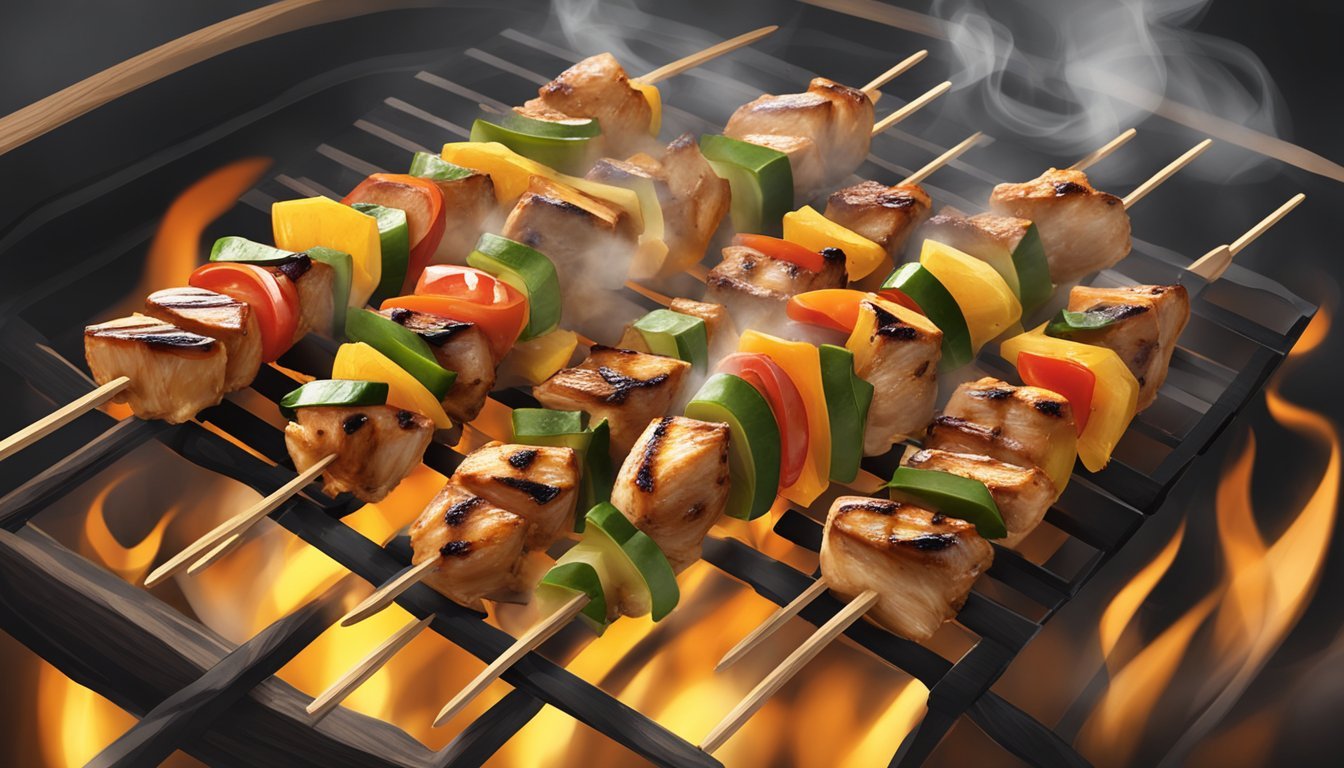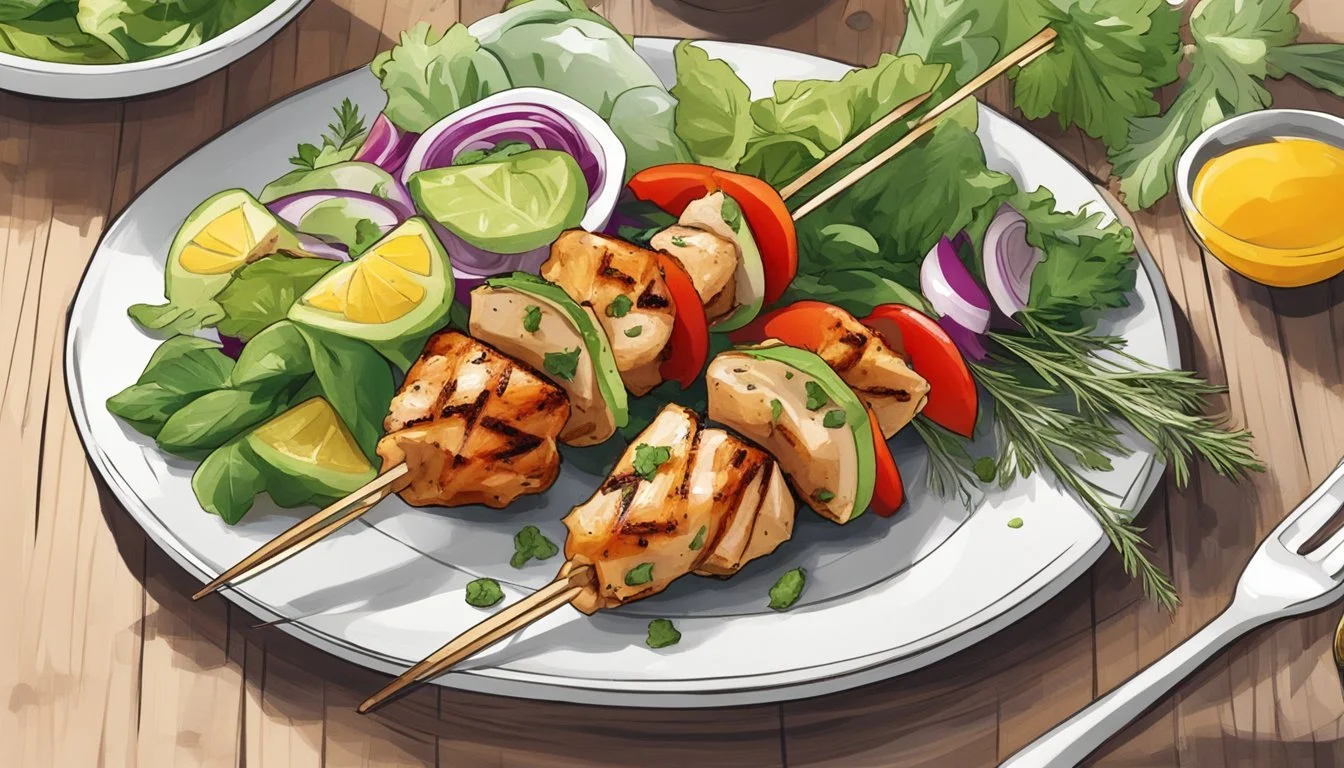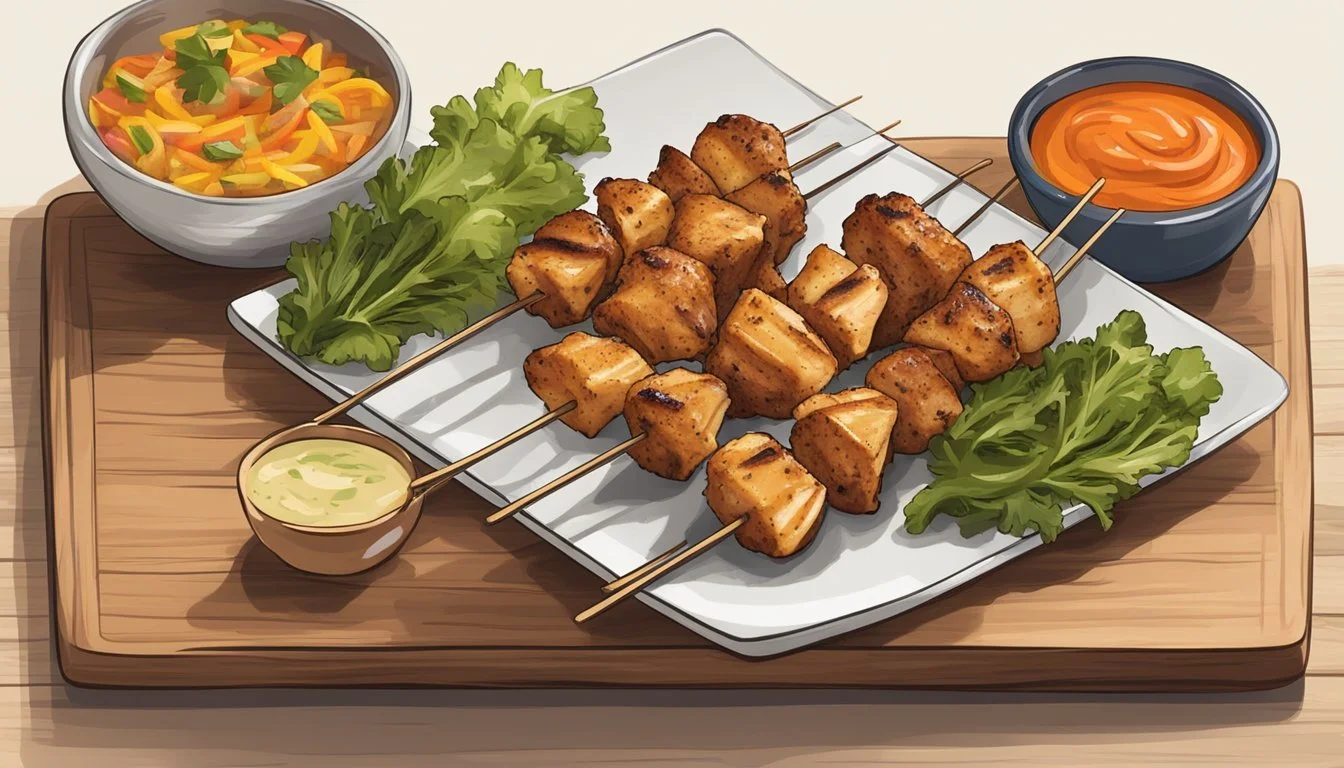How Long Do Gluten-Free Grilled Chicken Skewers Last?
Safe Storage Tips
Gluten-free grilled chicken skewers are a fantastic option for any meal, celebrated for their flavor and dietary inclusivity. When preparing these skewers, it's essential to consider their shelf life to ensure they remain safe and delicious. Typically, gluten-free grilled chicken skewers can last in the refrigerator for up to four days when stored properly in an airtight container.
If you have leftovers, you can also extend the lifespan of your skewers by freezing them. Properly frozen, these chicken skewers can last for up to three months, allowing you to enjoy a quick and convenient meal later. The key is to ensure they are well-sealed to prevent freezer burn and maintain their texture and taste.
Understanding shelf life helps in planning meals and minimizing waste. Whether used for a family cookout or meal prep, knowing how long your gluten-free grilled chicken skewers last ensures you maximize their flavor and nutritional benefits.
Understanding Gluten-Free Skewers
Gluten-free skewers provide a delicious option for those with gluten sensitivities or celiac disease. Key considerations include ensuring all ingredients are gluten-free and suitable for the dietary restrictions.
What Makes Skewers Gluten-Free
To ensure that chicken skewers are gluten-free, it's essential to use gluten-free soy sauce or tamari. Traditional soy sauce often contains wheat, making it unsuitable for those avoiding gluten. Tamari is a great alternative as it typically does not contain wheat. Another option is a soy-free, allergy-friendly sauce.
Marinades must be checked for any hidden gluten. Ingredients like teriyaki sauce, ginger, and garlic are usually safe, but it's crucial to read labels or make your own marinade using fresh, real food ingredients.
Choosing the Right Ingredients
Selecting the right cut of chicken is crucial. Both chicken breasts and chicken thighs can be used, depending on preference. Chicken breasts are leaner, while thighs offer a juicier option. It is also important to ensure the chicken is fresh and free from additives that could contain gluten.
When preparing the skewers, using fresh vegetables and ensuring they are washed and cut properly will provide additional flavor and nutrition. Common vegetables include bell peppers, onions, and zucchini. Thread them onto the skewers with the chicken, leaving a small space between each piece to ensure even cooking.
Lastly, always soak wooden skewers in warm water for at least 30 minutes before grilling to prevent them from burning. Alternatively, use metal skewers, which are reusable and heat-resistant.
Preparation Tips for Chicken Skewers
Proper preparation of chicken skewers ensures they are flavorful and cooked to perfection. This involves steps from selecting the right chicken cuts to mastering the skewering technique with adequate marination time.
Selecting and Prepping the Chicken
Choosing the right cuts of chicken is crucial. Both chicken breasts and thighs work well. While chicken breasts are leaner, thighs offer a juicier texture. Cut the chicken into bite-sized cubes for even cooking and better flavor absorption. It's essential to ensure uniformity in size to facilitate even grilling. Washing and patting the chicken dry with paper towels will help the marinade stick better.
Creating the Marinade
A good marinade elevates the flavor of the chicken skewers. Common ingredients include soy sauce, honey, garlic, ginger, and pepper. For a gluten-free option, coconut aminos can replace soy sauce. Adding a balance of salt and spices like paprika and onion powder enhances depth. Mix ingredients in a good ratio, for example:
2/3 cup soy sauce (or coconut aminos)
1/4 cup honey
2 tablespoons olive oil or sesame oil
2 minced garlic cloves
1 tablespoon fresh grated ginger Marinate the chicken for 30 minutes to 24 hours in a sealed container or zip-lock bag in the refrigerator.
Skewering Technique
Proper skewering contributes to the final dish's presentation and cooking. Soak wooden skewers in water for at least 30 minutes to prevent burning. Thread the marinated chicken cubes tightly but leave slight gaps to ensure they cook thoroughly. If using metal skewers, a light brush of oil will prevent sticking. Consistently flip skewers during grilling, typically every 5 minutes, ensuring all sides are evenly cooked. Cook on a preheated grill at medium heat, around 350-450°F, until the internal temperature reaches 165°F.
These preparation techniques help in creating delicious and safe-to-eat chicken skewers.
Cooking and Grilling
Cooking and grilling gluten-free chicken skewers require attention to grill setup, temperature control, cooking techniques, and determining doneness to ensure safe and delicious results.
Grill Setup and Temperature Control
A proper grill setup is crucial for consistent cooking. Preheat the grill to medium heat (350°F) to ensure even cooking of the chicken skewers. Both charcoal and gas grills can be used; select according to personal preference and equipment availability.
Use nonstick cooking spray on the grates to prevent sticking. Thin layers of oil brushed on the grates or skewers work well too. If using wooden skewers, soak them in water for at least 30 minutes before grilling to prevent burning.
Cooking Techniques for Chicken Skewers
Marinate the chicken pieces to enhance flavor and tenderness. Common recipes include teriyaki chicken skewers and other BBQ marinades. Place diced chicken and marinade into a resealable bag, refrigerating for at least 30 minutes or up to 24 hours.
Thread chicken onto metal or wooden skewers, alternating with vegetables if desired. Cook chicken skewers over medium heat, turning every 3-4 minutes. This ensures even cooking and helps achieve a slight char without burning.
Determining the Doneness
The most reliable method to determine if chicken skewers are done is by measuring the internal temperature. Insert an instant-read thermometer into the thickest part of the chicken pieces. Chicken is fully cooked when it reaches 165°F (75°C).
Visually, cooked chicken skewers should have juices running clear and no pink in the center. Total cook time generally ranges from 10 to 15 minutes, but thicker pieces may require more time. Paying close attention to these details ensures safe and delicious grilled chicken skewers.
Serving Suggestions
Grilled gluten-free chicken skewers can be part of a well-balanced meal when paired with the right sides and presented attractively. Here are some ideas to make your meal a hit.
Pairing with Sides
Rice: A simple side of steamed white or brown rice complements the flavors of grilled chicken skewers. For a more vibrant dish, consider a pilaf with diced bell peppers and onion.
Salads: Fresh and crunchy options like coleslaw or potato salad make excellent accompaniments. Consider adding zucchini noodles or a cucumber salad for a refreshing contrast.
Grilled Vegetables: Grilling season provides an opportunity to add peppers, zucchini, and onions to the skewers. They can be cooked simultaneously, adding both nutrition and color to the meal.
Bread: Gluten-free flatbreads or tortillas can be served alongside to create wraps or to soak up juices from the skewers.
Garnishing and Presentation
Sesame Seeds: Sprinkling sesame seeds over the skewers can add both crunch and a subtle, earthy flavor.
Herbs: Freshly chopped cilantro or parsley can be used as a garnish to impart a fresh aroma and vivid green color.
Serving Plate: Arrange the skewers on a large platter with lemon wedges, thinly sliced bell peppers, and a small bowl of dipping sauce, such as tzatziki or garlic aioli.
Color Harmony: Using a variety of brightly colored vegetables will make the dish visually appealing, enticing guests to indulge.
Texture: Adding a sprinkle of crushed nuts or crispy fried onions can provide contrasting textures, elevating the eating experience.
Nutritional Information
Gluten-free grilled chicken skewers offer a healthy and tasty meal option. Below is a detailed look at the nutritional components and dietary considerations associated with this dish.
Macronutrient Breakdown
Protein: These skewers are a fantastic source of protein. A typical serving might contain around 25-30 grams of protein, supporting muscle growth and repair.
Carbohydrates: Typically, these skewers are low in carbohydrates, especially when not marinated in sugary sauces. Expect around 5-10 grams of carbs per serving.
Fat: The fat content depends on the cut of chicken used and the preparation method. On average, expect around 3-7 grams of fat per serving, with some variations in saturated and unsaturated fats.
Calories: One serving generally provides about 150-250 calories, making it a nutrient-dense option for those monitoring their caloric intake.
Sugar: Minimal sugar content is expected, mainly from marinades if used, contributing around 1-5 grams.
Nutrient Approx. Amount (per serving) Protein 25-30 grams Carbohydrates 5-10 grams Fat 3-7 grams Calories 150-250 Sugar 1-5 grams Sodium Varies based on seasonings
Dietary Considerations
Paleo: These skewers can fit perfectly into a paleo diet, especially when seasoned with natural herbs and spices without added sugars.
Nut-Free: Generally prepared without nuts, making them a nut-free option.
Sodium: Sodium content varies. Using low-salt marinades can keep sodium levels manageable, around 300-500 mg per serving.
Saturated Fat and Cholesterol: Skewers usually have low saturated fat and cholesterol, promoting heart health. Values can range from 1-3 grams of saturated fat and 50-70 mg of cholesterol.
Micronutrients: Chicken skewers provide essential micronutrients like vitamin B, potassium, iron, and calcium. One can expect to get between 5-10% of the daily iron and 2-4% of daily calcium requirements per serving.
Micronutrient Highlights:
Vitamin A: Essential for vision and immune health
Vitamin C: Supports the immune system
Iron: Crucial for blood health
Labeling gluten-free grilled chicken skewers accurately and understanding these nutritional points helps in making informed dietary choices.
Storage and Shelf Life
Proper storage techniques and appropriate refrigeration and freezing procedures are crucial to maximizing the shelf life of gluten-free grilled chicken skewers. Following these guidelines will ensure the best taste, texture, and safety of your leftovers.
Proper Storage Techniques
To keep gluten-free grilled chicken skewers fresh, place them in an airtight container soon after cooling to room temperature. Wrapping the skewers tightly in plastic wrap or aluminum foil before storing in the container can help maintain moisture and flavor.
Label the containers with the date of storage to easily track freshness. Ensuring minimal air exposure is key, as air can lead to faster spoilage due to bacterial growth.
Refrigeration and Freezing Procedures
In the refrigerator, gluten-free grilled chicken skewers can last for up to 3-4 days. For longer storage, freezing is an excellent option, extending the shelf life to several months.
Before freezing, wrap the skewers in plastic wrap or aluminum foil, then place in a freezer-safe container. Thaw frozen skewers in the refrigerator before reheating to maintain the best texture and safety.
By following these storage and refrigeration methods, your gluten-free grilled chicken skewers will remain safe to eat and delicious for an extended period.
Safety and Food Handling
Proper food safety and handling are crucial for ensuring that gluten-free grilled chicken skewers are safe to consume. Key considerations include preventing cross-contamination and ensuring safe reheating practices.
Cross-Contamination Concerns
When preparing gluten-free grilled chicken skewers, avoiding cross-contamination is critical. Designate separate utensils, cutting boards, and grilling areas for gluten-free foods.
For example, reserve the top rack of the grill exclusively for gluten-free items. Use tinfoil or dedicated grill mats to create a barrier between gluten-free skewers and potential gluten-containing residue on the grill. Consider marinating the chicken in a separate container and using fresh containers for any leftover marinade.
Reheating and Consumption Safety
Reheat gluten-free chicken skewers to an internal temperature of 165°F to ensure they are safe to eat. Avoid reheating more than once as this can increase the risk of contamination and foodborne illness.
Consume leftovers within three to four days. Store remaining skewers in airtight containers in the refrigerator to maintain freshness and reduce the risk of bacterial growth. If freezing leftovers, wrap each skewer individually to prevent freezer burn and label with the date for easy reference.
Alternative Ingredients and Variations
Exploring alternative ingredients and variations can make gluten-free grilled chicken skewers interesting and adaptable for various dietary preferences and flavor profiles.
Substitutions for Common Allergens
Many traditional recipes involve common allergens like soy sauce, dairy, and certain oils. Soy sauce can be replaced with coconut aminos, which provides a similar umami flavor without gluten. This is especially helpful for those avoiding soy products.
For recipes calling for dairy, such as certain marinades, avocado oil or coconut milk can be used. They offer a creamy texture without dairy proteins. If your recipe includes honey, those needing to avoid it can opt for maple syrup as a sweet alternative.
Marinades and sauces often include brown sugar; it can be substituted with coconut sugar or date syrup for a different yet complementary sweetness. Cornstarch is another common ingredient that can be replaced with arrowroot powder for those needing a grain-free option.
Creative Flavor Twists
For a fresh take on gluten-free grilled chicken skewers, consider creative flavor twists. Incorporate spices like smoked paprika and cayenne to balance sweetness with a smoky or spicy kick.
Try a blend of garlic, ground ginger, and sesame oil to recreate a teriyaki-inspired marinade using gluten-free soy sauce or coconut aminos.
Rice vinegar and ginger pair wonderfully with shrimp instead of chicken, offering an alternative protein option. A citrus-based marinade with flavors like lemon or lime juice along with fresh herbs like cilantro can also add a bright, zesty flavor to the skewers.
Experimenting with different oils such as avocado oil can change the overall taste and texture. For additional depth, a hint of five-spice powder or turmeric can add intriguing flavors to the marinade.









